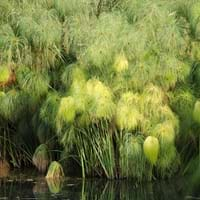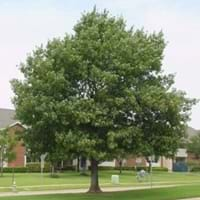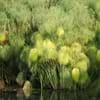Life Span
Perennial
Perennial
Origin
Africa
Northeastern United States, Mid-Atlantic United States, Southeastern United States, North-Central United States, Central United States, South-Central United States, Canada
Types
C. papyrus, C. papyrus 'Nanus
Ashford Oak, Chase Creek Red Oak, Shera-Blair Red Oak
Number of Varieties
Not Available
Habitat
Lakes, Shores of rivers or lakes, sluggish streams and rivers, Swamps
Sandy areas, Upland, Wooded slopes, Woodlands
USDA Hardiness Zone
7-11
3-9
Sunset Zone
H1, H2, 16, 17, 23, 24
1a, 1b, 2a, 2b, 3a, 3b, 4, 5, 6, 7, 8, 9, 10, 11, 12, 14, 15, 16, 17, 18, 19, 20, 21, 22, 23, 24
Habit
Clump-Forming
Oval or Rounded
Flower Color
Tan
Yellow green
Flower Color Modifier
Bicolor
Bicolor
Fruit Color
Brown
Brown, Sienna
Leaf Color in Spring
Green, Light Green
Green, Dark Green
Leaf Color in Summer
Green, Light Green
Green, Dark Green
Leaf Color in Fall
Green, Light Green
Red, Brown, Dark Red, Bronze
Leaf Color in Winter
Green, Light Green
Not Available
Leaf Shape
Grass like
Maple shaped
Plant Season
Spring, Summer, Fall, Winter
Spring, Summer, Fall
Sunlight
Full Sun, Partial Sun
Full Sun, Partial Sun, Partial shade, Full Shade
Type of Soil
Clay, Loam, Sand
Clay, Loam, Sand
The pH of Soil
Neutral
Acidic, Neutral
Soil Drainage
Poorly Drained
Well drained
Bloom Time
Indeterminate
Spring
Tolerances
Drought
Pollution, Drought, Salt
Where to Plant?
Container, Ground, Pot
Ground
How to Plant?
Stem Planting
Seedlings, Stem Planting
Plant Maintenance
Medium
Medium
Watering Requirements
Average Water Needs, Keep ground moist, Requires a lot of watering
Do Not over Water
In Summer
Lots of watering
Lots of watering
In Spring
Moderate
Moderate
In Winter
Average Water
Average Water
Soil pH
Neutral
Acidic, Neutral
Soil Type
Clay, Loam, Sand
Clay, Loam, Sand
Soil Drainage Capacity
Poorly Drained
Well drained
Sun Exposure
Full Sun, Partial Sun
Full Sun, Partial Sun, Partial shade, Full Shade
Pruning
Remove damaged leaves, Remove dead branches, Remove dead leaves
Remove damaged leaves, Remove dead branches, Remove dead leaves
Fertilizers
All-Purpose Liquid Fertilizer
Don't fertilize within a year of planting
Pests and Diseases
fungus
Borers, Caterpillars, Galls, Moth, Red blotch, Scale
Plant Tolerance
Drought
Drought, Pollution, Salt
Flowers
Showy
Insignificant
Flower Petal Number
Single
Not Available
Foliage Texture
Not Available
Coarse
Foliage Sheen
Glossy
Matte
Attracts
Flying insects, Hummingbirds
Birds, Butterflies
Allergy
Not Available
Not Available
Aesthetic Uses
Showy Purposes
Showy Purposes
Beauty Benefits
Not Available
Not Available
Edible Uses
Insignificant
Yes
Environmental Uses
Air purification
Air purification
Medicinal Uses
Cancer, Heals minor burns, Wounds
Not Available
Part of Plant Used
Stem
Whole plant
Other Uses
Constructing Boats, Used as fuel, Used in paper industry
Used as Ornamental plant
Used As Indoor Plant
Yes
No
Used As Outdoor Plant
Yes
Yes
Garden Design
Bog Garden, Container, Feature Plant, Houseplant, Mixed Border, Water Gardens
Shade Trees, Street Trees
Botanical Name
CYPERUS 'Wild Spike'
QUERCUS rubra
Common Name
Papyrus, Wild Spike Cyperus
Northern Red Oak
In Hindi
पेपिरस संयंत्र
उत्तरी लाल ओक
In German
ägyptischen Papyrus-Pflanze
Roteiche
In French
Papyrus égyptien
chêne rouge
In Spanish
Papiro egipcio
el roble rojo del norte
In Greek
αιγυπτιακό πάπυρο
βόρειο κόκκινο δρυς
In Portuguese
Papiro egípcio
carvalho vermelho do norte
In Polish
Papiro egipcio
dąb czerwony
In Latin
CHARTA
Quercus rubra
Phylum
Magnoliophyta
Magnoliophyta
Class
Agaricomycetes
Magnoliopsida
Family
Cyperaceae
Fagaceae
Clade
Angiosperms, Commelinids, Monocots
Angiosperms, Eudicots, Rosids
Tribe
Cariceae
Not Available
Subfamily
Cyperoideae
Not Available
Number of Species
Not Available
Not Available
Importance of Egyptian Papyrus and Northern Red Oak
Want to have the most appropriate plant for your garden? You might want to know the importance of Egyptian Papyrus and Northern Red Oak. Basically, these two plants vary in many aspects. Compare Egyptian Papyrus and Northern Red Oak as they differ in many characteristics such as their life, care, benefits, facts, etc. Every gardener must at least have the slightest clue about the plants he wants to plant in his garden. Compare their benefits, which differ in many ways like facts and uses. The medicinal use of Egyptian Papyrus is Cancer, Heals minor burns and Wounds whereas of Northern Red Oak is Not Available. Egyptian Papyrus has beauty benefits as follows: Not Available while Northern Red Oak has beauty benefits as follows: Not Available.
Compare Facts of Egyptian Papyrus vs Northern Red Oak
How to choose the best garden plant for your garden depending upon its facts? Here garden plant comparison will help you to solve this query. Compare the facts of Egyptian Papyrus vs Northern Red Oak and know which one to choose. As garden plants have benefits and other uses, allergy is also a major drawback of plants for some people. Allergic reactions of Egyptian Papyrus are Not Available whereas of Northern Red Oak have Not Available respectively. Having a fruit bearing plant in your garden can be a plus point of your garden. Egyptian Papyrus has no showy fruits and Northern Red Oak has no showy fruits. Also Egyptian Papyrus is not flowering and Northern Red Oak is not flowering . You can compare Egyptian Papyrus and Northern Red Oak facts and facts of other plants too.





